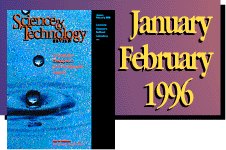 PDF format (2495K)
PDF format (2495K)
 The Lawrence Livermore National Laboratory's groundwater cleanup program has made dramatic strides in removing contaminants underneath the Laboratory and nearby area. Individual contaminant plumes are effectively targeted for hydraulic capture and cleanup by a Livermore team of researchers. Their use of hydrostratigraphic analysis integrates chemical hydraulic, geologic, and geophysical data, which results in a three-dimensional model of the subsurface area. The resulting hydrostratigraphic framework developed at Livermore is proving to be a highly useful management tool to plan, budget, implement, and monitor the groundwater cleanup effort. Researchers expect to transfer their knowledge to other remediation sites. Dollar savings so far have been in optimally placing extraction wells, thereby maximizing contaminant removal and saving time.
The Lawrence Livermore National Laboratory's groundwater cleanup program has made dramatic strides in removing contaminants underneath the Laboratory and nearby area. Individual contaminant plumes are effectively targeted for hydraulic capture and cleanup by a Livermore team of researchers. Their use of hydrostratigraphic analysis integrates chemical hydraulic, geologic, and geophysical data, which results in a three-dimensional model of the subsurface area. The resulting hydrostratigraphic framework developed at Livermore is proving to be a highly useful management tool to plan, budget, implement, and monitor the groundwater cleanup effort. Researchers expect to transfer their knowledge to other remediation sites. Dollar savings so far have been in optimally placing extraction wells, thereby maximizing contaminant removal and saving time.
 Invented and developed at Lawrence Livermore National Laboratory is an inexpensive and highly sensitive, low-power radar system that produces and samples extremely short pulses of energy at the rate of 2 million per second. Called micropower impulse radar (MIR), it can detect objects at a greater variety of distances with greater sensitivity than conventional radar. Its origins in the Laboratory's Laser Directorate stem from Nova's transient digitizer. The MIR's extraordinary range of applications include security, search and rescue, life support, nondestructive evaluation, and transportation.
Invented and developed at Lawrence Livermore National Laboratory is an inexpensive and highly sensitive, low-power radar system that produces and samples extremely short pulses of energy at the rate of 2 million per second. Called micropower impulse radar (MIR), it can detect objects at a greater variety of distances with greater sensitivity than conventional radar. Its origins in the Laboratory's Laser Directorate stem from Nova's transient digitizer. The MIR's extraordinary range of applications include security, search and rescue, life support, nondestructive evaluation, and transportation.
 and LLNL Disclaimers
and LLNL Disclaimers
UCRL-52000